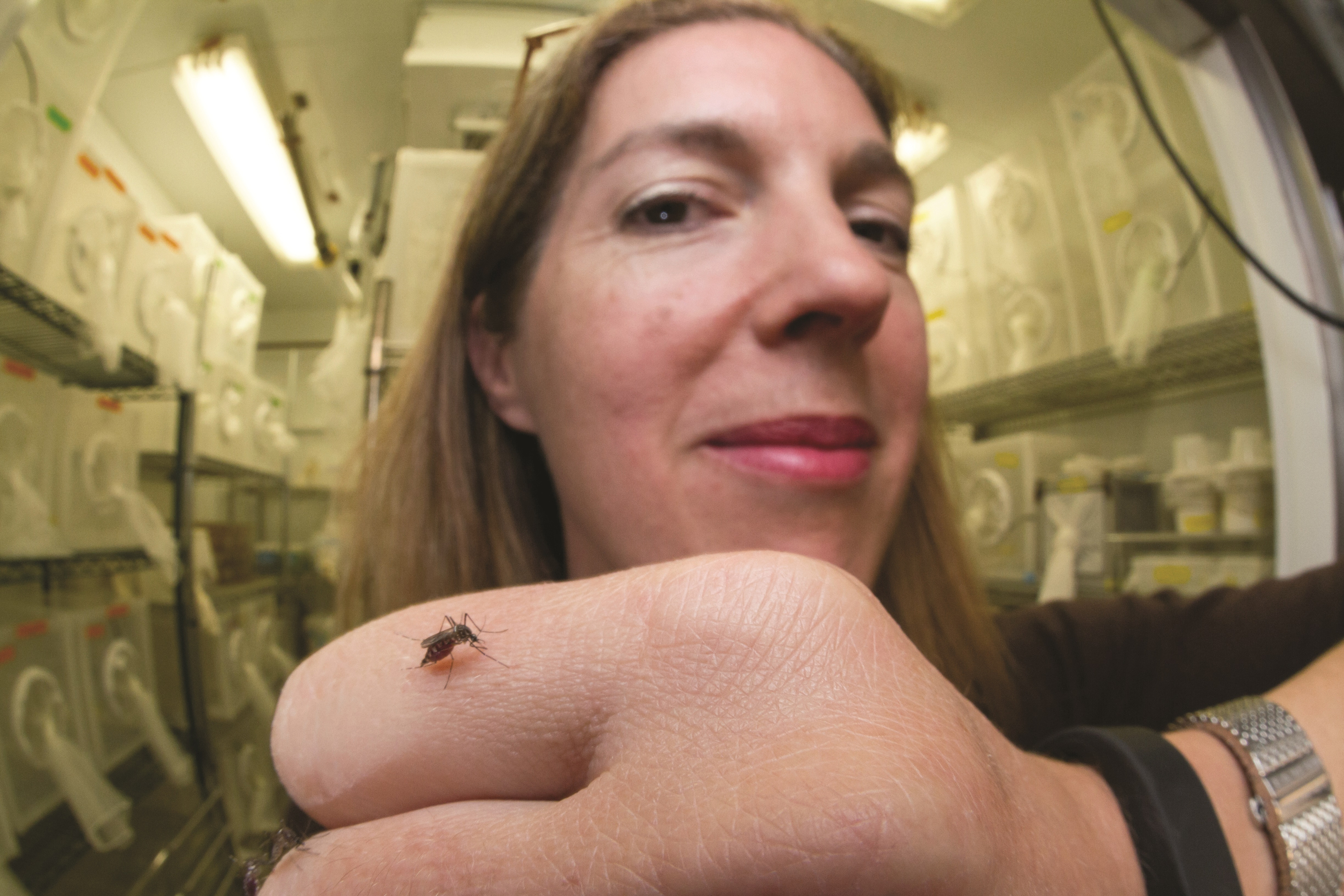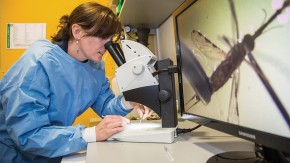Leslie Vosshall and a hungry female mosquito in the Rockefeller University mosquito room.
MOLECULAR APPROACHES TO ALTER OLFACTORY-DRIVEN BEHAVIORS OF INSECT VECTORS
- Jan 1, 2016
- Download Retrospective

A female malaria-transmitting Anopheles gambiae mosquito displaying characteristic white-tipped appendages (elongated palpi). Rockefeller University. Photo courtesy of Alex Wild.
Richard Axel, Columbia University, United States
Leslie Vosshall, The Rockefeller University, United States
Leslie Vosshall joined Nobel Prize-winner Richard Axel's neurobiology laboratory at Columbia University as a young scientist. Her charge: Identify how the fruit fly Drosophila melanogaster employs a sophisticated sense of smell to direct its behavior.
Twenty years later, through a series of twists and turns, that initial scientific journey plumbing the biology of odor detection has turned Vosshall into one of the leading authorities on why mosquitoes hunt humans. Discoveries she first made during seven years of single-minded research in Axel's lab have led to a lab of her own at The Rockefeller University, a prestigious appointment as a Howard Hughes Medical Investigator, and invitations to speak around the world. And, with the help of a five-year, $5 million grant from the Bill & Melinda Gates Foundation's Grand Challenges in Global Health program, Vosshall, in collaboration with Axel, has uncovered a new way to prevent malaria by jamming mosquitoes' ability to stalk and bite humans.
Finding new ways to shield humans from the mosquitoes that carry malaria is a vital front in the global battle against the disease. Each year about 600,000 people die in Africa and other tropical regions - most of them children - due to a bite from the Anopheles gambiae mosquito that carries the malaria parasite Plasmodium falciparum. The female Anopheles usually bites in the late evening to obtain blood with the protein-rich nourishment that her fertilized eggs need to mature. That's why bed-nets coated with pesticides have gained favor as an effective way to counter the deadly infections. As the insects have developed resistance to the pesticides, developing new ways to thwart the bugs has become a major objective of the Gates Foundation and other public health organizations. That's why bed-nets coated with pesticides have gained favor as an effective way to counter the deadly infections. As the insects have developed resistance to the pesticides, developing new ways to thwart the bugs has become a major objective of the Gates Foundation and other public health organizations.
In the early 1990s, Axel and Vosshall (pronounced Voss-hall) were using new laboratory tools to explore the biology of smell. The battle against malaria was not part of their plan. "Neither Leslie nor I had any knowledge of insect-borne diseases most common in the developing world," Axel recalls. And yet the central finding of their collaboration, a gene called orco first characterized by Vosshall in fruit flies, prompted the two scientists to begin mapping the neurobiology that is vital to the spread of insect-borne diseases.
"We believe the best way to interfere with insect behavior like biting humans is to first identify the many elements of that behavior at the very basic molecular and cellular level," Axel says. "Any other approach just won't work."
Pursuing the orco gene met that criterion. But unraveling the gene's critical role in the mosquitoes' pursuit of human blood involved years of perseverance and frustrating setbacks. In the end, the researchers discovered that orco produces a protein in the nerve cells of the mosquito's antennae, which is essential for the insect to sense most odors - such as the distinctive scents humans secrete in their sweat and breath. When Vosshall realized that the Orco protein is a central olfactory switch common to all insects, the gene - and the protein it generates - became a prime target for disrupting all kinds of bug behaviors.
That discovery has led to new approaches in pesticide research, including using molecular genetics to figure out exactly how insects detect humans in order to develop compounds that keep them away from us. Several companies, including Bayer CropSciences of Germany, are seeking broad-spectrum agricultural pesticides that selectively deactivate the Orco protein.
The company initiated its work on Orco as a result of a collaboration with Axel and Vosshall that was funded with $350,000 over two years, part of a $2 million two-year extension grant from the Gates Grand Challenges in Global Health program. While Bayer is continuing to work on Orco-inhibiting repellants for agricultural pests, the company says it ended its effort to develop a mosquito-specific product when the grant concluded in 2012.
When Vosshall joined Axel's lab back in 1993, it had been just two years since Axel and Linda Buck[1] had identified the nerve receptors that rodents use to detect odors - a discovery for which they were awarded the Nobel Prize in 2004. Since the Drosophila fly has long served as a model for investigating cellular processes in higher forms of life, including humans, "We thought it would be an important achievement to find Axel-Buck receptors in the fly, and that finding them would be pretty straightforward," Vosshall says. "We were wrong."
After four years of "failure after failure" with Vosshall and fellow post-doctoral researcher Hubert Amrein sifting bit by bit through the DNA in the fly's antennae for genes similar to the ones found by Axel and Buck in rats "we had to concede that insects must use a totally different mechanism than vertebrates," Vosshall says. "We exhausted every possibility looking for the obvious."
At Axel's suggestion, Vosshall went back to basics, testing Drosophila genes for those that met three assumptions: olfactory genes in the fly had to code for proteins located in cells in the antennae; the proteins should have a so-called "transmembrane structure," meaning they sit astride a cell's outer skin, able to transmit external signals - like odors - across the cell membrane, creating an electrical signal to the brain; and there had to be a large number of closely related genes to accommodate the many aromas released by plants.
In 1998, with the genes still unknown, Vosshall's hunt received an invaluable boost when two separate research groups[2] produced a preliminary sequence of the Drosophila genome (a full genome map was completed in 2000). The team used software to scan for DNA sequences that encode for transmembrane proteins, and were able to pluck out 10 gene groups that met their criteria.[3] Meanwhile, John Carlson and others were also using the genome sequence to identify candidate odorant receptors.[4]
Even so, it still took another five years to identify the full gene for the Orco (short for olfactory receptor co-receptor) protein and detail precisely how it works. By that time, Vosshall was running her own lab at The Rockefeller University. She and others had found that odor molecules pass through tiny pores in insects' sensory hairs, called sensilla. Sensilla, like tiny noses, populate insect antennae and another appendage on a bug's head, called maxillary palps. From there, the odor molecules flow onto nerve cells that contain odorant receptors (ORs).
The biggest surprise came from experiments that showed that in order for an insect to identify a specific odor, it had to stimulate a specific OR that contains two protein subunits. One of the OR subunits is sensitive to a limited number of odorants. There are many different genes encoding these odorant-specific subunits.
The other subunit is always Orco. When the odorant-specific subunit and Orco, the common subunit, come together they create a signaling pathway that allows the insect to identify a specific odor.

In a groundbreaking study published in 2004, Vosshall and her lab at Rockefeller reported that flies engineered to contain defective versions of Orco were unable to respond to different scents even when genes for the odorant-specific subunits remained intact.[5] In addition, unlike other odor-detecting receptors that varied from insect to insect, Orco was consistently observed among all insects tested.
"It really took 10 years of research to fully isolate the orco gene and determine its central role," says Vosshall. Her lab also determined that each odorant-specific receptor subunit needed to lock onto the Orco protein - much as two Lego pieces click together - in order to open a neural circuit identifying a scent. Vosshall says she inquired about possible funding from the U.S. National Institute of Allergy and Infectious Diseases for a grant to further explore the Drosophila olfactory mechanism, but she was turned down because it wasn't deemed valuable to understanding human disease. Work on vector problems, they told her, must be done on the vector insect, not modeled in flies or moths.
About then, Axel says, his interest in public health problems in Africa was piqued for the first time during an unrelated visit there. "I started thinking about how little time and effort science in the U.S. as compared to Europe was focused on health problems in the developing world," he says. That's one reason the request for proposals in 2004 from the newly created Grand Challenges in Global Health caught his attention. "It was immediately apparent to me that we could translate our findings in the fly to other insects," he says.
"Our reasoning was pretty simplistic that we could develop compounds to globally disrupt the insect's sensory system," he says. With the grant in hand, "Leslie began transitioning her lab from Drosophila to mosquitoes."
Vosshall used the funding to test the more than 100,000 molecules in Rockefeller's chemical database for one that could turn off the Orco protein's switch in a mosquito. "We didn't know what we were looking for so we tried everything," Vosshall says. It took almost three years just to perfect the test, called an assay, which required growing a culture of cells that express the orco gene. "We'd put in the gene and come back the next days and the cells would be dead," she says. "And when we got the gene in, we couldn't get it to express the protein. Richard's lab and ours had to develop all sorts of sophisticated tricks to make the system work."
In 2010, just when the grant was running out, Vosshall's lab found several related molecules that disable the action of the mosquito ORs by acting on the Orco subunit. But to develop a commercial product - the goal specified by the Gates Grand Challenges in Global Health grant - the researchers needed the help from an industry partner. Axel traveled to Germany and, armed with a $2 million extension of the grant into 2012, he persuaded Bayer to join a three-way partnership in which the company received $350,000 over two years to expand on Vosshall's work.
Within six months, Bayer had screened a few million compounds using Vosshall's cell assay, and by the end of the first year, the company's scientists narrowed the search to several classes of chemicals.
The Bayer team found that the compounds blinded mosquitoes to humans and similarly disrupted moths and other crop-destroying pests. "Bayer accomplished in six months what took us four years," Vosshall says.
Meanwhile, during research conducted under the Grand Challenges in Global Health grant, Vosshall identified - first in flies and later in mosquitoes - the receptors in antennae neurons that respond to carbon dioxide in human breath.[6] Mosquitoes engineered with mutations affecting the carbon dioxide receptor were slower to respond to the presence of humans.[7] And in other studies, Vosshall has found that mosquitoes that transmit human diseases utilize both carbon dioxide and odorant receptors to find a live human on which to feed.[8]
"It turns out mosquitoes have multiple ways to find humans," Vosshall says. "Our belief now is that a really effective repellant will have to contain a combination of compounds that disable the Orco protein and CO2." At present, however, no company is pursuing this avenue of research. Commercial interest is likely to emerge when further research shows an Orco targeting compound can lead to an agricultural product as well as a mosquito repellant. Companies have told the researchers that commercial profits are necessary to justify producing a low-cost repellant for the developing world.
Vosshall is continuing work first begun under the Gates Grand Challenges in Global Health grant, and is "completely focused on understanding mosquito behavior," she says. Her lab is now studying the biology of how a blood meal changes female mosquito behavior. For a few days after a blood meal, females lose interest in humans. So harnessing this natural suppression in behavior may also yield ways to interfere with the spread of malaria. Vosshall is using her Howard Hughes funding to support the research and in 2010 also received a $600,000 grant from the National Institute of Allergy and Infectious Diseases to help back the lab's work.
"The (Grand Challenges in Global Health) grant has changed my career," she says. "I'm solely focused now on studying mosquitoes and I'm optimistic that our continuing studies will eventually lead to a new repellant."
THE SCIENCE:
Uncovering the molecular mechanisms of olfactory-driven behavior
Vosshall and Axel have been studying the molecular basis of olfactory-driven behavior in mosquitoes that transmit human diseases, e.g. malaria and dengue fever, in an effort to understand how this behavior drives their preference for feeding on human hosts. Odors are sensed via specialized chemosensory receptors including odorant receptors (OR) in sensory neurons. In insects, ORs are transmembrane, heteromeric proteins composed of an odorant selective subunit and the evolutionarily conserved protein subunit Orco (olfactory receptor co-receptor).
Vosshall and colleagues developed a line of Aedes aegypti, the mosquito that transmits dengue virus and that primarily feeds on humans, with a mutation in the gene encoding Orco. This mutant line lost their strong preference for humans over other animals.[8] They subsequently discovered that differences in 0r4, a gene that encodes one of the odorant selective subunits, between wild-type populations of Ae. aegypti helps to explain why one subtype of this mosquito feeds predominantly on humans while another subtype does not.[9]
Further experiments revealed that the orco mutant mosquitoes only lost their attraction to host-derived volatile compounds in the absence of CO2. Subsequently, the investigators found that the CO2 receptor was also required for attraction to body temperature and lactic acid.[7] Together, these studies and others reveal how a mosquito's host-seeking behavior is controlled by the integration of multiple sensory modalities i.e., CO2, odorants, and heat,[10] suggesting that a cocktail of compounds will be required to inhibit it. Collectively, the study of the mechanisms underlying olfactory behavior in Ae. aegypti and other insect vectors provides new opportunities for the development of attractant traps and repellents.
REFERENCES:
[1] Buck at the time was a post-doc in Axel's lab and is now at The Fred Hutchinson Cancer Research Center in Seattle where she is investigating the mechanisms underlying the sense of smell and pheromone sensing in mammals.
[2] The Berkeley Drosophila Genome Project and the European Drosophila Genome Project.
[3] Vosshall LB, Amrein H, Morozov PS, Rzhetsky A, Axel R. A spatial map of olfactory receptor expression in the Drosophila antenna. Cell 96, 725-36 (1999).
[4] Clyne PJ, Warr CG, Freeman MR, Lessing D, Kim J, Carlson JR. A novel family of divergent seven-transmembrane proteins: candidate odorant receptors in Drosophila. Neuron 22, 327-38 (1999).
[5] Larsson MC, Domingos Al, Jones WD, Chiappe ME, Amrein H, Vosshall LB. Or83b encodes a broadly expressed odorant receptor essential for Drosophila olfaction. Neuron 43, 703-14 (2004).
[6] Jones WD, Cayirlioglu P, Kadow JG, Vosshall LB. Two chemosensory receptors together mediate carbon dioxide detection in Drosophila. Nature 445, 86-90 (2007).
[7] [a],[b] McMeniman CJ, Corfas RA, Matthews BJ, Ritchie SA, Vosshall LB. Multimodal integration of carbon dioxide and other sensory cues drives mosquito attraction to humans. Cell 156, 1060-71 (2014).
[8] [a],[b] DeGennaro M, McBride CS, Seeholzer L, Nakagawa T, Dennis EJ, Goldman C, Jasinskiene N, James AA, Vosshall LB. orco mutant mosquitoes lose strong preference for humans and are not repelled by volatile DEET. Nature 498, 487-91 (2013).
[9] McBride CS, Baier F, Omondi AB, Spitzer SA, Lutomiah J, Sang R, Ignell R, Vosshall LB. Evolution of mosquito preference for humans linked to an odorant receptor. Nature 515, 222-7 (2014).
[10] Potter CJ. Stop the biting: targeting a mosquito's sense of smell. Cell 156, 878-81 (2014).



